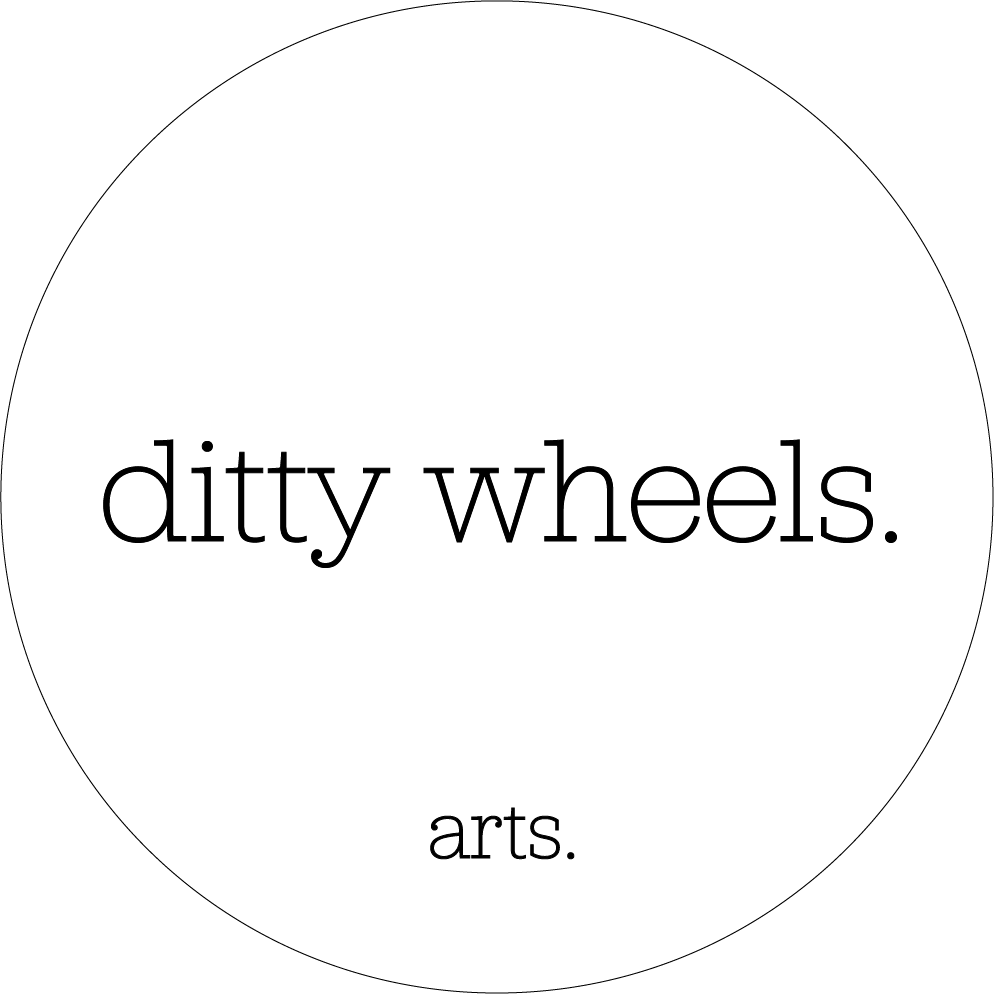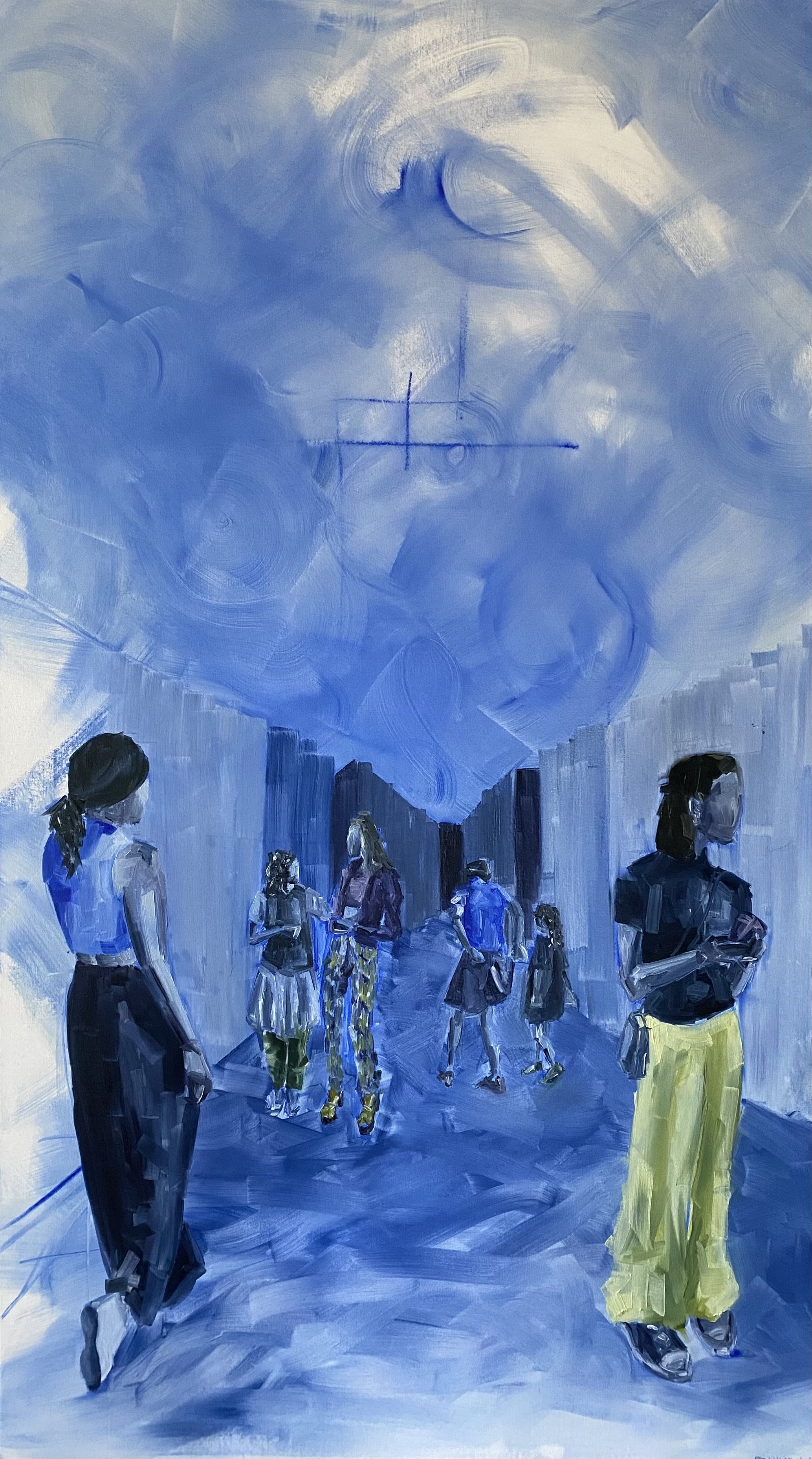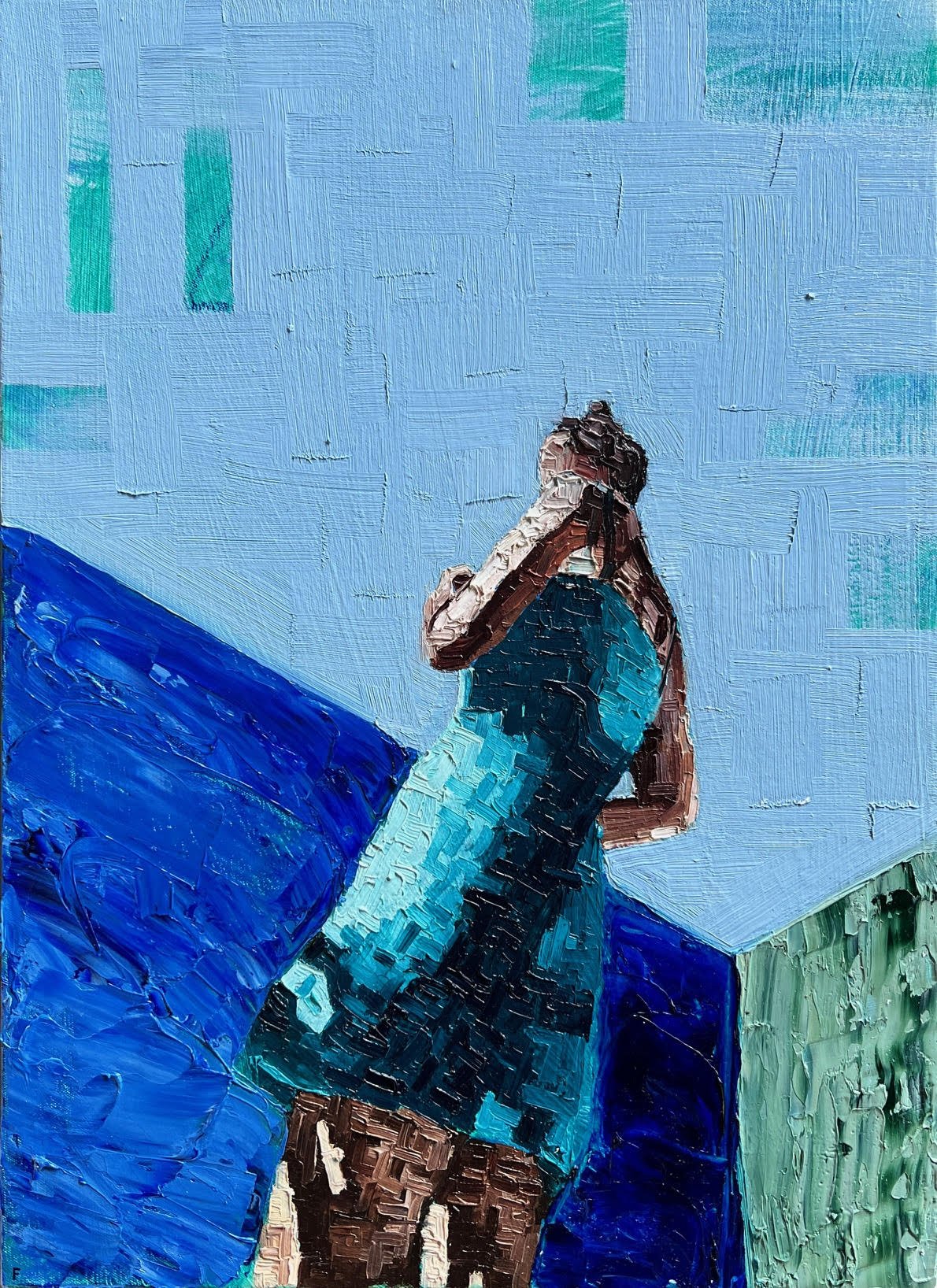Frankie LA
'There is something so simple, disturbing and oddly poetic about some regular things in this world.
There are moments, buildings and people that fascinate me.
I want to create live paintings.
I want the figures to move and bend, in space and time.’
In and Out, 1600 x 900, Oil on Canvas, $1650
Reaching, 970 x 1205, Oil on Canvas, $1600
The Love Affair of Orange and Blue, 970 x 1200, Oil on Canvas, $1650
Day Out - 60x90cm - Oil on canvas - $1550
First Sunny Day in Winter - 40 x 55cm - Oil on canvas - $550
The Men They Stand - 60 x 75cm - Oil on canvas - $1200
A Word From Frankie.
I am not such a stranger to words. I have always found solace in speaking; speaking up, speaking out and I’m sure if you know me, speaking loud.
Picture making however, is a stranger. Creating visual art creeped its way into my life. We have an interesting and complicated relationship. Every time I feel like I am starting to figure them out, they throw a curve ball. asshole.
Paint can show you how it feels to be in this world, it can express a piercing memory, a political stance, love, hate, hope. It can also show you how the colour red looks next to the colour orange. I am not being poetic here, I am being quite literal. You can always find meaning if you look for it. I kill myself over trying to sound intelligent when talking about my work. When I get like this I am reminded of something a mentor once told me. “Im just a painter Luce, Im not saving the world”.
I am a painter. And although the world needs saving, my practice won’t do it.
The works I have created for my show have been a process and an experimentation of the human form and its varying weight in changing landscapes. I have attempted, in various ways, to create a push and pull of space, alternating between opaque and translucent paint and rendering figures using a combination of palate knife application and mark making. The people I paint all mean something to me. As time goes on and people change the meanings of these painting do as well. People are complex and ever-changing. I hope my paintings are too.
I want to create live paintings.
I want the figures to move and bend, in space and time.
I want the figures to live in the constraints of the oil paint grind lines, however be freed by rooms with no ceilings and lines with no form. This dissolves into a constant process of wrestling with paint, with lots of additions inevitably being wiped back. In the words of De Kooning, it is ‘a continuous seeking and rejecting of resolution or closure’. I want the painting to be alive. I want them to breath.
Being a painter has always been a point of self exploration. I have this enduring curiosity with my own obsession of being an image maker.
There is something so simple, disturbing and oddly poetic about some regular things in this world. Sitting in your childhood home, or walking the halls of your old high school or checking the bus route at night. There are moments, buildings and people that fascinate me.
How you choose to use the tools of painting has endless possibilities. I am just scratching the surface of this practice. Why I do what I do is not so much a concern, although I do often wonder what possess someone to sit in a room, day in day out and place paint to canvas. It is more the question of how, how do I create these images in my head and how do I use the language of painting to speak. This is exciting.
Because, it is about the paint and the act of painting.
Rose Wylie’s work, a favourite of mine, was described in a New York Times article as ‘gloriously big and crude’. I enjoy this description so much. Paintings are so much more than pretty. To draw on a Steve Lopes quote, paintings need to have ‘a little poison’ in them to be enduring. I believe the paintings I have created have elements of beauty, however I will continue to add a little more poison every day. Perhaps they might even be as crude and big and glorious as ‘Getting down or falling up’ by Georgie Spain or ‘Pin Up and Porn Queen Jigsaw’ by Wylie herself.
All through the trials and tribulations and bad paintings it is the work which always brings me back. The solitude of the sacred studio space grounds me.
I build these worlds and I intend on staying in them. To reference Steve once again, he told me “find your inner world and protect it”.
Thank you Steve; I will.
With Love,
Frankie LA
An Interview with Frankie LA.
Local artist Frankie LA was an art-loathing sport nut, until she walked into Frame88 as a mid-teen. She discovered that art wasn’t so bad, thank you very much, and has since become an absolute machine in the up-and-coming art scene. Artist, muralist, and possibly the youngest gallery owner in history, Frankie is self-powered, self-aware and won’t be told that it can’t be done. Hold on to your hats, kids, this girl’s going places.
Did you grow up with strong art influences? What started you on your arty path?
“It’s funny, actually. I was not an artistic kid, not at all that way inclined. I was a sporty kid, I played sport all the way through school. I didn’t do art though high school either, I dropped it the first second I could. I remember getting so annoyed that I had to go to Art class, which is hilarious to me now.
My mum was a practicing nurse, but she’s always been an artist, she’s always loved drawing and painting. I had an art room across from my bedroom my whole life, and never took any notice of it until I was 16 or 17, when I started getting a little more interested in politics. I think that marriage to art came from graffiti and street art and the politics in it; my love for painting came from there. I remember seeing it all around me and I guess all those different things got brought together when I started working at Frame88. I was about 16, and there I fell in love with the beauty of art. I grew this passion for it and decided pretty quickly that I was going to go to NAS (National Art School.) I picked up a subject at school so that I could create a portfolio for NAS. From there, it was just about honing skills, really, because I had the drive and the want to do it. I got in contact with a street artist I love called Fintan Magee - I emailed him late at night like a little fangirl - and he emailed me back, and he’s been a friend and a mentor ever since. He’s a massive inspiration for me. I remember seeing his studio and his day-to-day work life and just thinking, “this is me. I could totally do this.” I went to NAS and studied it, and now I’m about to finish. My mum for sure has always been very supportive of me wanting to go to art school, which I know isn’t that common for a lot of people wanting to be artists, so I’m very lucky.”
Talk to me about your time at Frame88
“I always had this idea that you are one thing, and that you can catagorise other people in the same way, you know “he’s the sporty kid, he’s the social kid, he’s the arty kid,” whatever, but as you get older, those things don’t make sense anymore, they’re more limiting than anything else. What I learned at Frame is that those boxes don’t really exist. You can have a business mindset and still be artistic. You can be heaps of things that I didn’t think go together. That was important. Also, Mel gave me so much freedom as a kid; really, she had no reason to give me any freedom artistically, but she just nurtured my budding creativity, and let me learn on my own as well, which I’m really grateful for. And the opportunities I got there, you know; I was involved in curating and setting up exhibitions and working with people creatively and aesthetically, from a young age. It gave me this confidence, and I think that did wonders for me - not having come from an artistic background personally, not really, to then have that nurtured by someone like Mel was awesome.”
You’re in your last year at National Art School, how’s that been this year?
“It’s been challenging (due to Covid lockdowns), having to work without a studio space – it was so nice having somewhere to go every day and having other artists to work collaboratively with. A lot of classes have been pushed back, we’re just doing Drawing and Art History online, but I’m lucky that I have space at home to work, which I know is not the case for a lot of my friends. I’ve been keeping quite active in painting, but I miss NAS.
My friend was saying she’s finding it really hard to make work; it feels like the world is ending a bit, and it makes it difficult to create. But artists have always made art though hard times, and if you can find the motivation, you go ok - I’m trying to find a rhythm with it and just being kinder to myself about what I make and how I make. It’s been difficult in not knowing when we can go back, to continue to make work in the same capacity as we were at NAS – not that NAS is not expecting that, they’ve been incredibly kind through all of this, but we just all want to be back making.
I just want my third-year experience to be full, we have our BFA Show (Batchelor of Fine Arts) at the end of the year, which has also been pushed back. That’s why I’ve also been making at home; even though I don’t have classes for those pieces, I want to have a lot of options for the show at the end of the year.”
How has NAS changed you?
“Oh man, in so many ways. I think everyone should go to Art School – I have spent so much of my life in the last three years, actively learning to see and experience the world around me, and that has had an immense impact on who I am as an artist and as a person, and that’s completely invaluable. The last year of your degree is much more self-directed, which I think is fantastic because that’s what it’s like as a practicing artist. You get encouraged to put yourself into your work, and through doing that, you learn a lot about yourself. In the past three years I’ve learned so much about myself and I think that comes down to attention – to what’s around me, to how I’m responding to things.”
I’ve seen you produce predominately portraits, what draws you to people as your subjects?
“Figurative painting has always been my preferred mode, I’ve always been drawn to other people, to representing people. I have this argument regularly with one of my teachers; I argue that they’re not portraits; to me a portrait is about the person you’re painting. Although the people I’m painting have been modeled from people in my life, the works aren’t specifically about those people; they sit in for allegories or metaphors for something I’m thinking about at the time, or a feeling or concept. I’m trying to get away from being focused on the image I’ve taken - I feel like I’m too rigid in being so representational. For the work to be less about the person, I’m trying to be looser and not as strict about the representation. It’s not where I’m going in my work.”
You’re an artist and a muralist, have you been doing any mural work recently? What do you like about murals?
“This year I was set on getting my studio practice solid because it was my last year at NAS and because I want to be doing solo shows next year, and my mural works does take up a lot of my time and resources. It’s a way for me to get an income but I’ve put it aside for now. The last one I finished was last year, so it’s been a while. But I’ll always love doing murals, I love large-scale painting and public art so it’s not going anywhere for me.”
I love shots of your gridwork before you start painting; to see your work half-painted, half-gridded, is quite striking. Is that a common practice, have you always done it?
“I would say that’s not very common practice, I learned that from street art. Fintan (Magee) actually taught me that, he does that in his paintings. For a lot of years, it was purely a means to an end – a way for me to get scale and proportion up quickly so I didn’t have to do five hours of drawing, I could just go straight into painting, because that’s always the bit I’ve been eager to get to. No one in my cohort does that, although people do use different forms of gridding - it’s called the Overlay Method - but yeah, people used the have the same reaction: “what are all these lines and numbers? What is this?” As I’ve continued to use it, I’ve started leaving some exposed in my finished pieces, although I don’t think I’ve ever got to a point where I’m totally happy with that. I still need to hone it. I’ve been using thicker oil sticks rather than acrylic in my more recent works, and that effect has made it look like my people are held up by scaffolding. That’s how I see it. That’s what I paint, people in their particular environments, and it looks like they’re kind of stuck, or I’ll paint the same person multiple times in the same environment, and it’s this play between movement and being stagnant, which is kind of how it all feels at the moment. I want to keep using the grid, just using different materials to get a different effect from the grid. I’m still playing with it. I don’t know where I’m going with it but I know I’m getting somewhere! I don’t know what the question is, but I know there’s an answer!!”
Your Nom de Plume, or Nom de Brush as it were, is Frankie LA. What’s the story behind the name?
“I toyed around with the name for a bit and decided if I didn’t do it now, I wouldn’t, so I’ve leapt in. My mum said to me on my 18th, “I should have called you Frankie,” and I was like, “What?! Yes! You should have called me Frankie – I. Love. That. Name!!” So, Frankie, and LA are my initials, so I’m signing all my work now, Frankie LA. I don’t love my name, and I never really settled on a sign for my paintings, and I kind of like having a “brand” that I can channel my art through. I like that it’s gender neutral and it’s nice to have it as a bit of a persona for me. A lot of artists have alter egos and it’s an idea I really like; having another name to go by, having another person to step into when you’re doing your work, and to be able to step out of it as well and just be Lucy.”
What do you want for yourself and your art?
“I want to, more than anything, be a full-time practicing artist. I want to have an established studio practice, to do solo shows and to be represented by galleries and be able to get my art out there. It’s on the backburner now, but I do want to have a mural practice as well. I always wanted to travel with this, to show in other countries and be internationally recognized. They’re my dreams, but honestly, I just want to paint forever. I’ve always wanted to be successful in the fields I go into.
I know I’ve only been in this thing for a little while, but it humbles you, it’s hard. It’s really difficult. And sometimes it feels like right now there are even fewer options than there were before for artists. But the field is quite diverse, and saying I want to do something for the rest of my life feels like a long time, so changing my options feels good too. Before Covid, a friend and I opened a gallery, which is no longer in operation because, you know, Covid, but that was a really great experience, I really loved that. If I can help other artists hone their practice, that’s where I’d want to go for sure. The way I treated sport is how I treat art; it really is my life. One of my art teachers said to me once “you never quit art.” You can stop making art, you can stop showing your work, but it’s a way of looking at the world, and a way of experiencing things and once you let that in, it has a really big impact on you, and that’s everlasting.”
Interview by Erin Short






